Monday, August 31, 2009
An Update of Sorts on NorthSide
A few items jump out at me.
No Eminent Domain on Churches
Paul J. McKee, Jr. lays to rest one of the rumors circulating: that his companies plan to use eminent domain on churches. McKee says:
"We've bought some churches from people who want to sell them. If they want to sell them, we'll buy them. But can you imagine asking for eminent domain for churches? That would be short of insanity. We spend a lot of time putting to sleep those kind of rumors."
Indeed, many churches have voluntarily sold parcels and church buildings to the developers, and others are actively supporting the project. Those that remain could enjoy great benefits to their surroundings should the plan come to fruition. The origin of the church rumor was nothing more than the poorly-prepared list of parcels needed for the project that was released by the St. Louis Development Corporation. Seriously, that list looked less like a sinister plot than a cut-and-paste job with owner-occupied parcels removed and everything else retained without a final proofreading.
What Happened to the Forum?
McKee's comments about McEagle's removal of the public forum on his website is lacking. Here's what the article reports:
McKee also defended the fact that a website for the project shut down an area where people could go on and make anonymous comments. He said the forum had degenerated and was not serving any constructive purpose.
In reality, McEagle moderated every aspect of the site. Julie Guignon at McEagle had to approve requests to set up an account on the board, and either Guignon or someone else deleted inappropriate posts. The only posts that were ever published were all thoughtful, intelligent requests for information or maintenance, and were made in response to leading questions like "What Information Do You Want to See?" posted by a site moderator. None of the suggestions or questions ever got a real response.
McEagle's formerly open media strategy had received kudos from the St. Louis Social Media Report. As an often skeptical observer of the project and its public relations blunders, I was quick to praise the unconventional move.
Let me retract that praise and call the media strategy a bizarre failure. McEagle tapped into social media like no developer before, received praise even from long-time critics, posted some content and then...killed its own momentum (and new found good will) by closing up shop prematurely.
CBA Group Opposed to Any TIF?
The Northside Community Benefits Alliance seems opposed to any form of tax increment financing for the NorthSide project. Keith Marquand, the group's treasurer, is quoted:
"Ronald Reagan had the saying, 'Trust but verify,' " he said. "I don't understand why we should have any basis for trust whatsoever. Look at the city's record with TIF projects. ... The city doesn't have a very good record of enforcing agreements with developers."
I think that McEagle has the votes to pass even a $410 million TIF through the Board of Aldermen. The TIF alone doesn't upset me because I think that TIFs were designed exactly for the purpose proposed by McEagle: renewal of truly distressed areas. The real problem, of course, remains the scale of development, resident displacement and lack of solid urban design and historic preservation guidelines.
What is questionable, and what does not likely have a majority of aldermanic votes, is city backing of half of the TIF. After St. Louis Centre's failure and the city's wise refusal to grant backing to Ballpark Village, McEagle faces an uphill battle on that point.
Of note in the initial TIF application is that without city backing, the developer projects a 3.21% profit on the project, and with such backing projects an 8.21% profit. Hence, the project is still profitable without the city backing the bonds.
On the other hand, if the City of St. Louis had to pay $205 million should the developer default -- and remember, no one assumed that Pyramid would ever fail -- the city government would go bankrupt.
Building Losses Continue to Accumulate in NorthSide Project Area
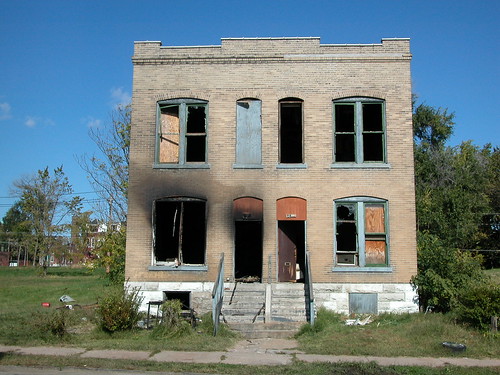 The sad end of the McEagle-owned four-family flats at 2621 Sullivan Avenue in JeffVanderLou is complete. Brick thieves have taken down the sturdy historic building, leaving a pile of rubble. Last year, a small fire struck the building (see "Fire Strikes House in JeffVanderLou", October 30, 2008). The photograph above commemorates an only slightly better day for the building.
The sad end of the McEagle-owned four-family flats at 2621 Sullivan Avenue in JeffVanderLou is complete. Brick thieves have taken down the sturdy historic building, leaving a pile of rubble. Last year, a small fire struck the building (see "Fire Strikes House in JeffVanderLou", October 30, 2008). The photograph above commemorates an only slightly better day for the building. Mark this as yet another historic building to be lost under the ownership of McEagle and its subsidiaries. Two years ago, this building was occupied and had minimal code citations. Then, it went vacant and soon after was visited by fire. The owner, Sheridan Place LLC, did little to address the fire. According to city records, the Building Division had to board up the building in the wake of the fire and then sent notice to the owner.
Mark this as yet another historic building to be lost under the ownership of McEagle and its subsidiaries. Two years ago, this building was occupied and had minimal code citations. Then, it went vacant and soon after was visited by fire. The owner, Sheridan Place LLC, did little to address the fire. According to city records, the Building Division had to board up the building in the wake of the fire and then sent notice to the owner.Now, the building is gone. Would this building have contributed to a new historic district? Could it have been rehabilitated using state and federal historic rehabilitation tax credits? (McEagle listed a whopping $149.7 million in historic tax credits as revenue on its first-draft tax increment financing application.) Was this one of planner Mark Johnson's "legacy properties" identified for preservation? We'll never know, because McEagle has not divulged any of its preservation plans. We do know that this building sits in one of the projected "employment centers," so it could very well have been doomed anyway. Yet that's just a guess.
Citizens and their elected representatives contemplating a redevelopment agreement for McEagle's NorthSide project need facts that demonstrate commitment on the part of the developer to back up all of its promises about historic preservation. Meanwhile, the facts that speak loudest about commitment to saving historic buildings don't match the developer's promises.
Ravaged brick buildings, constant fires, collapsing walls, missing boards and dozens of sound historic buildings now forever lost seem like the antithesis of the carefully-planned preservation of "legacy" buildings described by McEagle's executives and NorthSide master plan author Johnson (of Civitas, Inc.). Certainly, this slipshod management belies Johnson's immense professional reputation and commitment to progressive, community-oriented planning ideals. It's hard for seasoned preservationists to believe that McEagle really wants to save historic buildings in the project area -- but that is what the company and its planner keep saying they want to do.
Sunday, August 30, 2009
Making a Difference on the Riverfront
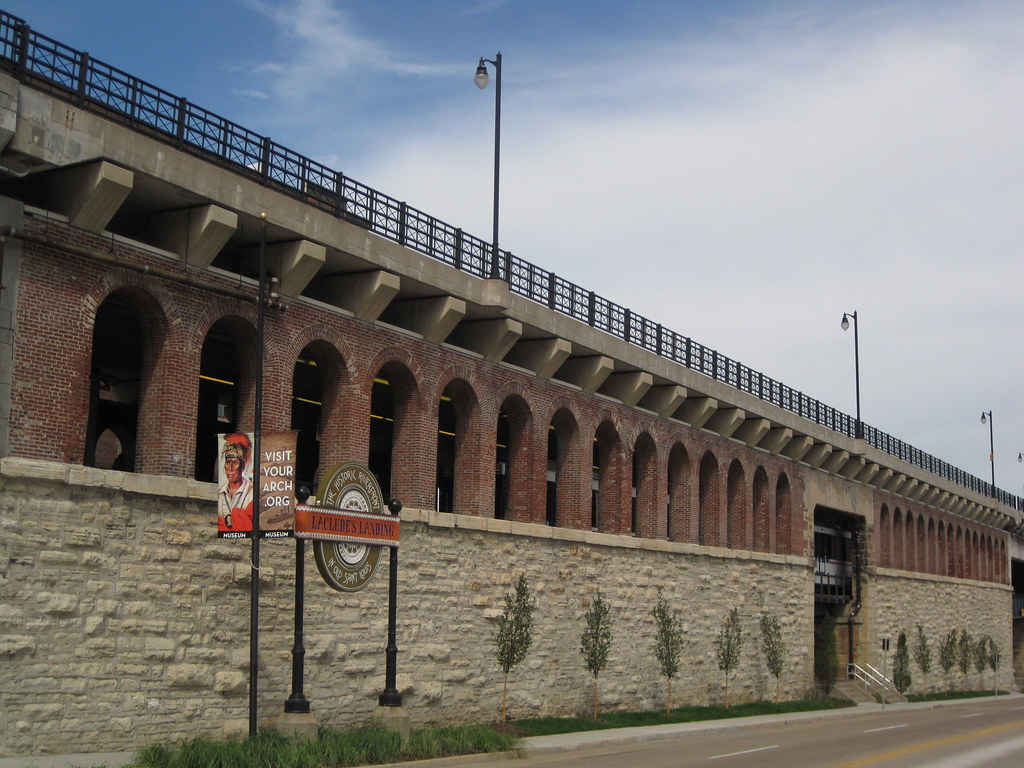
The southern flank of the mighty Eads Bridge has received a major landscape upgrade, due to the efforts of Metro, the Jefferson National Expansion Memorial and the Laclede's Landing Redevelopment Corporation. That is to say, the strip between the bridge approach and Washington Avenue actually now is landscaped! The difference between the formerly part-mulch, part-dirt terrain and the new verdant tree-planted, grassy, flowery setting could not be more stark.
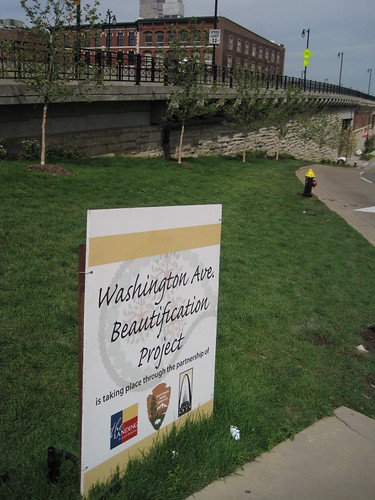 For years, this area was a disgraceful disarray in an area marred by many such urban design problems, including the intrusive elevated section of I-70, the parking garage barrier on the northern edge of the Memorial and the lackluster riverfront itself. The "Washington Avenue Beautification Project" does not resolve these larger issues, but vanquishes the terrible appearance of a very-visible area. Pedestrians on the Eads Bridge can now look out at the Gateway Arch and grounds, and look down and see an extension of that inviting park setting.
For years, this area was a disgraceful disarray in an area marred by many such urban design problems, including the intrusive elevated section of I-70, the parking garage barrier on the northern edge of the Memorial and the lackluster riverfront itself. The "Washington Avenue Beautification Project" does not resolve these larger issues, but vanquishes the terrible appearance of a very-visible area. Pedestrians on the Eads Bridge can now look out at the Gateway Arch and grounds, and look down and see an extension of that inviting park setting.I do have a quibble with the project concerning the lack of sidewalk on most of this side of Washington. (The other side of the street has a continuous sidewalk.) The photograph on the left shows the sidewalk running east from Second Street to First Street, while that on the right shows the strip running west.
 |  |
Addition of metered parking here -- something that Metro, operator of the garage, would likely oppose -- would be desirable. Meters would relieve parking problems on the Landing and calm traffic. However, a continuous sidewalk would be needed. Perhaps this issue can be explored in any design competition that the National Park Service (NPS) undertakes for the Memorial. NPS' draft general management plan for the Memorial identifies the parking garage site as potentially worth repurposing, so this corridor could be transformed at some point.
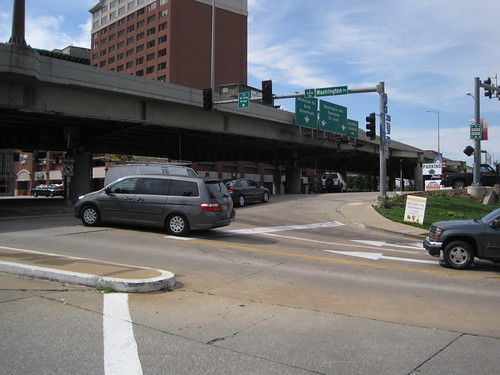 Of course, the sidewalk would lead westward walkers out into the morass of the Eads Bridge/Memorial Drive/Washington Avenue intersection. This intersection may be the most confusing in the city! Hopefully any design competition will lead to resolution of this problem, which plagues one of the Memorial's key entry points. Removal of the interstate is the most direct way to clarify traffic issues here, but that removal is probably on a slower track than the design competition timeline. Who knows? Perhaps the design competition will be the impetus for grad civic thinking on urban design, and our political leaders will embrace a visionary change downtown like those who laid out the Memorial did so long ago.
Of course, the sidewalk would lead westward walkers out into the morass of the Eads Bridge/Memorial Drive/Washington Avenue intersection. This intersection may be the most confusing in the city! Hopefully any design competition will lead to resolution of this problem, which plagues one of the Memorial's key entry points. Removal of the interstate is the most direct way to clarify traffic issues here, but that removal is probably on a slower track than the design competition timeline. Who knows? Perhaps the design competition will be the impetus for grad civic thinking on urban design, and our political leaders will embrace a visionary change downtown like those who laid out the Memorial did so long ago.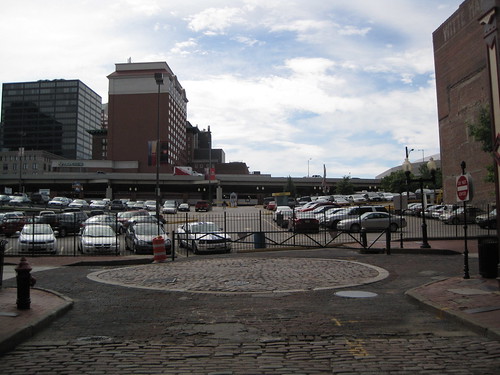
For now, the most-traveled pedestrian path between downtown and the Landing is right here. Can't see the path? Well, look carefully. There is a gate-sized opening in the fence of this parking lot on Second Street. People walk back and forth across this lot all day long, because it remains the most direct link between the Landing and downtown. It does not require much imagination to recognize that there is a major connectivity issue here. A sidewalk on Washington would have helped, although the larger disconnect between the riverfront and downtown remains the big problem.
The Washington Avenue Beautification Project points the way to a realistic way to implement changes to the riverfront that will add up to transformative action. While we need visionary leadership on the riverfront design challenge, we also need resolution of glaring quality of experience problems whose resolution is obvious. This space on Washington needed landscaping, and now it is landscaped. Laclede's Landing needs a better pedestrian connection to downtown. Perhaps a sidewalk on the north side of Washington is the way to go -- narrow the street, build a sidewalk along the new plantings. Perhaps the path already being used could be formalized through reconstruction of Lucas Avenue west through the parking lot. Let's follow one change with another and keep the momentum rolling.
Wednesday, August 26, 2009
Rabe Hall and Preserving Minor Mid-Century Modernism
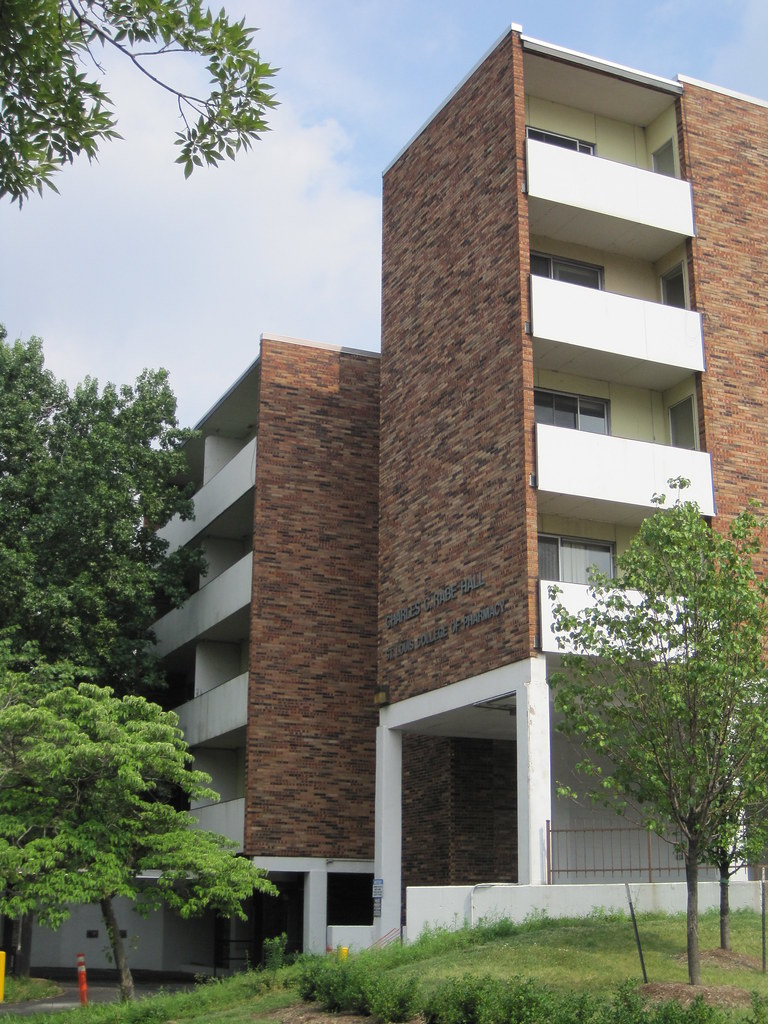
On Monday, the Preservation Board by voice vote unanimously approved demolition of the St. Louis College of Pharmacy's Rabe Hall at 4520 Forest Park Avenue in the Central West End. The Cultural Resources Office (CRO) recommended approval of the demolition permit, which was reviewed because the 17th Ward is covered by the city's preservation review program. The demolition will clear space for -- don't hold your breath -- surface parking. However, the College is the land to the Washington University School of Medicine and development of the site is likely. Much new construction has taken place on this block in recent years.
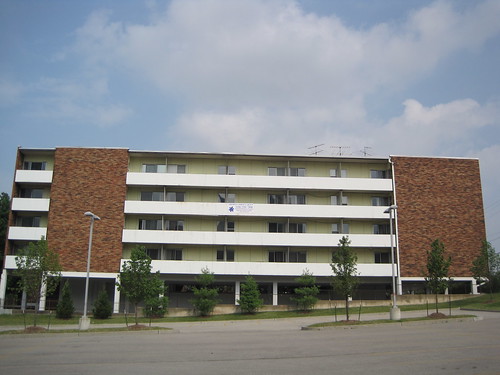
Preservationists quietly conceded this loss, due to several factors. For one thing, the San Luis Apartments battle took a lot of activist work, and captured a lot of the will to stand up to a powerful institution over a modern building whose architectural merit has yet to be widely realized. People saw a "done deal" and let it lie.

The timing of this post, I suppose, places me in the majority camp. However, I think that the demolition of Rabe Hall raises questions about the Cultural Resources Office and Preservation Board's treatment of mid-century buildings.
Rabe Hall is not exactly a masterpiece. In fact, historian Esley Hamilton points out that the greatest significance with Rabe Hall is that it occupies part of the site of Grape Hill, estate of Edward Bates. The building dates to 1964, when Town House Apartments West, Inc. took out a permit to build a 64-unit apartment building. The cost was $401,000 and the architect was Bert Luer, about whose work little is recorded. The final occupancy permit dates to December 17, 1965 -- not even 44 years ago. A 1977 building permit shows the owner as Washington University, making the conveyance cycle elliptical.
There are some charming features on Rabe Hall, especially the unique tapestry brick wall sections. The striking white columns and balcony walls are a fine contrast to that brick. Unfortunately, the yellow panels on the recessed walls replaced a more open fenestration that gave the building a more attractive look.
My point here is that Rabe Hall is not very old, its architectural pedigree is minor, and its design is not especially refined. Yet it is a handsome minor work of its period, has not outlived its functional life and is part of a cluster of modern buildings around the intersection of Forest Park and Taylor. The proposed use of the site is parking, not a new building.
What should CRO and the Preservation Board do in cases like this? We will get more chances to refine the approach, but it demands careful attention. Our proximity to the date of construction for Rabe Hall blinds many of us to later significance. Also, we are a ways off from developing a strong preservation approach to minor and workaday modern buildings, although historians have started to recognize the collective significance of districts of these buildings.
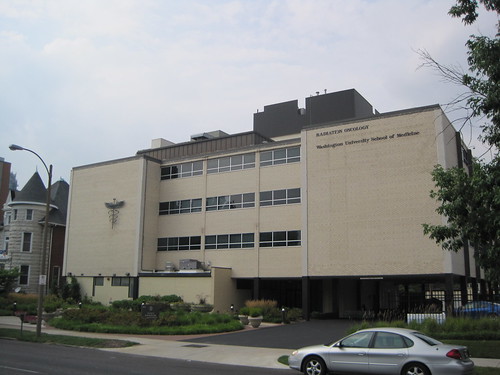 Across the street from Rabe Hall at 4545 Forest Park once stood the Parkway House Motel (1962), now demolished, and at 4511 Forest Park, a medical office building (1961) designed by California architect J. Richard Shelley. That office building raises the same questions as Rabe Hall. The one change, of course, is that now it is the last minor modernist work on the block. Strike three?
Across the street from Rabe Hall at 4545 Forest Park once stood the Parkway House Motel (1962), now demolished, and at 4511 Forest Park, a medical office building (1961) designed by California architect J. Richard Shelley. That office building raises the same questions as Rabe Hall. The one change, of course, is that now it is the last minor modernist work on the block. Strike three?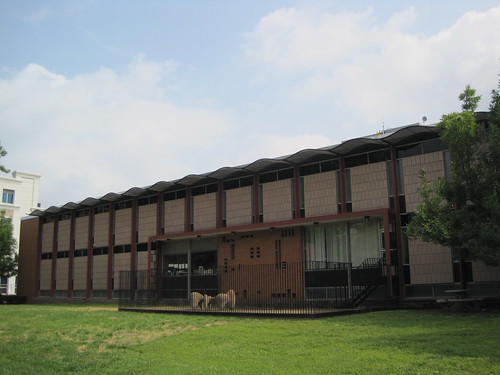 One block east on the south side of Forest Park is a building owned by Washington University more clearly worthy of protection. The Amalgamated Meat Cutters and Butchers Workmen of American Local 88 built the building at 4488 Forest Park in 1957. The renowned modern master Harris Armstrong designed the $100,000 clinic.
One block east on the south side of Forest Park is a building owned by Washington University more clearly worthy of protection. The Amalgamated Meat Cutters and Butchers Workmen of American Local 88 built the building at 4488 Forest Park in 1957. The renowned modern master Harris Armstrong designed the $100,000 clinic. The two-story building expresses great architectural originality, is the work of a master and is over 50 years old. Clearly, there is eligibility for both City Landmark and National Register of Historic Places designations. I would expect CRO to deny any demolition permit for this building. A strong individual work, the building benefited from the presence of modern buildings its construction encouraged. Most of that context will be gone soon.
Window Business
The owners and their window salesman (the same guy had both customers) made earnest arguments for allowing their use, but none of the arguments addressed the local historic district standards. Clearly, the salesman was not familiar with the ordinance, and he was the one who is trying to sell the windows to the homeowners over types that might have complied. He is one of many salesman or installers who have appeared before the Preservation Board. What distinguishes him is that he came to the Board before attempting to install the wrong windows.
The Board denied the application, but the matter raised a question in my mind: What if one of the requirements for obtaining a business license for window sales and/or installation was passing a written test demonstrating knowledge of the city's design and historic preservation ordinances?
Large Housing Development Underway in NorthSide Project Area
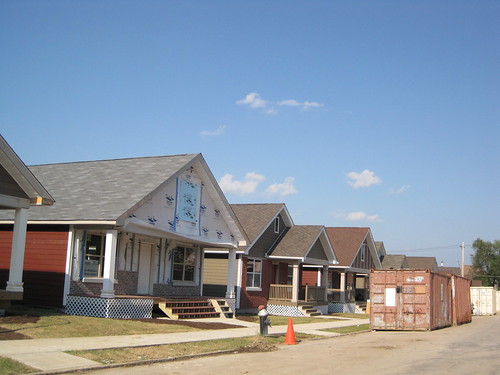 Thomas Avenue in the southeastern reaches of the JeffVanderLou neighborhood definitely is a construction zone. All day long, the street buzzes with the sound of large trucks, contractors speaking and power saws buzzing. The September deadline looms, and the developers are tough-minded about meeting that deadline. After all, these developers are known to be serious and uncompromising about their mission.
Thomas Avenue in the southeastern reaches of the JeffVanderLou neighborhood definitely is a construction zone. All day long, the street buzzes with the sound of large trucks, contractors speaking and power saws buzzing. The September deadline looms, and the developers are tough-minded about meeting that deadline. After all, these developers are known to be serious and uncompromising about their mission.Has construction on the NorthSide project started in a big and visible way?
Not quite. The construction is part of a phased 90-house development, and sits fully engulfed by the boundaries of the NorthSide project. However, the developer is not McEagle Properties but the non-profit Habitat for Humanity. The project has not received tax increment financing, nor is is formally part of the larger and more visible development. The Habitat for Humanity project in JeffVanderLou is a modest, steady effort that will transform a few blocks and 90 families' lives. If that is all that the project accomplishes -- and I doubt that will be the end -- it will have fulfilled a great need long before the larger project leads to even a shovel turn of earth.
Habitat for Humanity actually began this project in 2003, when it built 20 houses on Bacon, Garrison and St. Louis avenues in the northeast corner of the neighborhood. The St. Louis Equity Fund and the Jeff-Vander-Lou Initiative were development partners, and the Equity Fund remains involved in the subsequent phases. Neighborhood residents identified the need for this project as part of intensive community planning conducted as part of the Jeff-Vander-Lou Initiative process. This was development that came from the grassroots to serve the grassroots. These first homes largely consisted of two-story, flat-roofed townhouse-style buildings clad in brick and brick-like panels. Two of the double units on Bacon are shown here:
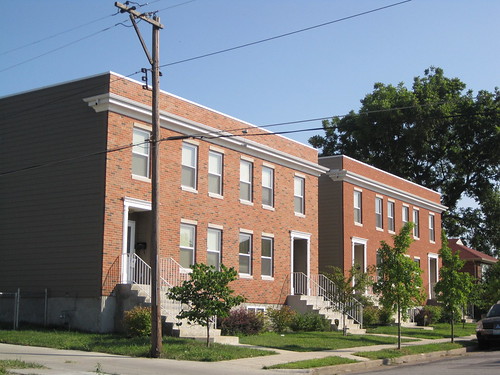 Architectural critics can pick at the details and materials, but I think that the houses demonstrate a creative use of a limited budget. The houses are compatible in form with their urban surroundings, and each one occupies a vacant lot. Construction ameliorated the effect of 20 vacant parcels in a pocket of the neighborhood. Readers who have lived in areas where there are 20 or more vacant parcels in a two-block area know exactly how transformative that can be.
Architectural critics can pick at the details and materials, but I think that the houses demonstrate a creative use of a limited budget. The houses are compatible in form with their urban surroundings, and each one occupies a vacant lot. Construction ameliorated the effect of 20 vacant parcels in a pocket of the neighborhood. Readers who have lived in areas where there are 20 or more vacant parcels in a two-block area know exactly how transformative that can be.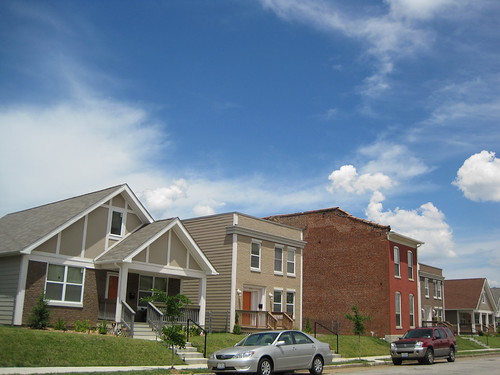 Like McEagle, Habitat for Humanity thought about JeffVanderLou on a large scale. The organization identified the need for more construction in the southeast part of the neighborhood, around the intersection of Sheridan Avenue and Martin Luther King Drive north of the reclaimed Blumeyer housing project. In summer 2008, Habitat for Humanity built 27 houses on Sheridan Avenue that received the Platinum LEED certification. As the photograph above shows, Habitat built around existing occupied buildings (there was some demolition of vacant buildings) and introduced a different house model.
Like McEagle, Habitat for Humanity thought about JeffVanderLou on a large scale. The organization identified the need for more construction in the southeast part of the neighborhood, around the intersection of Sheridan Avenue and Martin Luther King Drive north of the reclaimed Blumeyer housing project. In summer 2008, Habitat for Humanity built 27 houses on Sheridan Avenue that received the Platinum LEED certification. As the photograph above shows, Habitat built around existing occupied buildings (there was some demolition of vacant buildings) and introduced a different house model. The predominate house model is now a front-gabled, one-story home with front porch. Habitat for Humanity's architects developed two different models that alternate on longer expanses. There are differences in material colors, and homeowners have chosen some personal variations like substituting actual brick veneer for the concrete brick-like material more common to the development.
The predominate house model is now a front-gabled, one-story home with front porch. Habitat for Humanity's architects developed two different models that alternate on longer expanses. There are differences in material colors, and homeowners have chosen some personal variations like substituting actual brick veneer for the concrete brick-like material more common to the development.I think that the one-story model is charming, especially with the generous front porches. These houses embrace the life of the street, sending a strong message in a neighborhood that still has a lot of street crime. Eyes and ears on those porches will make a positive difference.
The houses now under construction on Thomas east of Elliott are 24 one-story, 1,184-square-foot houses that will sell for $77,000 each. These homes are of modest scale and materials, but there are unique things about them in addition to affordable price: these houses also meet Platinum LEED certification standards. Not only are these houses satisfying necessity in the social economy, they are doing the same in the ecological economy.
When this phase ends in September, a final phase that concludes in December will be underway. By New Year's Eve, 90 for-sale houses will have been added to JeffVanderLou in six years. That's an impressive feat for non-profit developers working on a community-driven process. Even more impressive will be the social impact of the houses.
As we contemplate the redevelopment ordinance that will initiate a much larger, private vision of development for this area, we should not forget that our best successes come from dreaming big but working small. Those who say that the scale of the solution must match the scale of the problem are right, but they are overlooking the scale of the community. As the Habitat for Humanity project shows, block by block makes a difference -- and adds up to big results quicker than we think.
Some photographs of the Habitat for Humanity project are online here. Television station KETC's Living St. Louis produced a segment on the project that appears online here.
Wreck Out!

This Thursday, Off Broadway hosts the Anti-Wrecking Ball, a joyous evening of entertainment for a worthy cause. Great bands and burlesque performers have contributed their talents to help raise money for legal fees needed for the Friends of the San Luis to appeal a circuit court judge's ruling that citizens have no standing to appeal the actions of the St. Louis Preservation Board.
We seek to overturn that ruling for future benefit. While the San Luis Apartments is lost, there will be future battles and citizens deserve full rights in each one of them. Join us Thursday to have great fun while building necessary financial resources.
Monday, August 24, 2009
All About City Landmarks
A City Landmark is a site designated through ordinance that has demonstrated historic significance in the development of the City of St. Louis. City Landmarks have legal protections against demolition and inappropriate alteration, in addition to official recognition of their value to our city.
St. Louis has designated 122 City Landmarks since the Board of Aldermen created the designation in 1966. However, the last City Landmark designation occurred over five years ago.
How Does a City Landmark Get Designated?
A citizen or preparer completes an application form that includes a building or site description, narrative history, photographs, a site plan, and a “preservation plan” outlining what alterations would be considered to alter the historic character. That plan will guide future decisions about the building.
The completed application goes to the city's Cultural Resources Office (CRO) for review and correction. That office will present the application to the Preservation Board, a nine-member commission composed of architects, historians, engineers and citizens appointed by the mayor. The Preservation Board holds an advisory vote on the application.
The final step requires support of the alderperson. The City Landmark application must be designated through ordinance by the Board of Alderman. The local alderperson will introduce a bill to make the designation official.
Can More Than One Building Be Designated?
Yes. Groups of as few as two or as many as several thousand buildings can be designated as a Local Historic District. The application process is similar, although the design guidelines typically are more extensive since multiple resources are included.
What Happens After the Designation?
All building permits for a City Landmark or Local Historic District structure go to the CRO for approval as well as the Building Commissioner. These permits would include demolition, major alterations and any changes specified in the preservation plan for the site or district. The CRO can deny the permit. The property owner can appeal CRO decisions to the Preservation Board for a hearing. The Board can uphold CRO denial or overturn it. If the owner wishes to appeal further, the matter goes to the city’s Planning Commission. If the Planning Commission does not grant the appeal, the owner can file suit in Circuit Court.
Also, a few City Landmarks have been demolished following fires or structural collapse. The Building Commissioner retains the power to issue an emergency condemnation for demolition order, and the CRO has no authority to halt or override such an order.
What Other Protections Exist in the City of St. Louis?
CRO has review over all demolition permits in wards that participate in the city’s Preservation Review program. Before 1999, this program covered the entire city but since then wards can opt in and out. Currently, all of the 28 wards participate except eight wards (4, 5, 7, 14, 18, 19 and 22). Additionally, CRO reviews demolition permits for all buildings listed on the National Register of Historic Places individually or through districts.
Is There Financial Assistance Available for Preserving City Landmarks?
The federal Historic Preservation Act of 1966 allows any Certified Local Government (CLG) to apply for an obtain grant money for preservation planning, stabilization and other work. St. Louis’ CRO participates in the CLG and is eligible for federal and state preservation grant funding. However, grant requests typically are initiated by concerned citizens who approach the CRO for assistance.
How Do I Contact the Cultural Resources Office?
Cultural Resources Office Director Kathleen Shea can be reached at 314-622-3400x206 or via email at SheaK@stlousicity.com.
Sunday, August 23, 2009
Corner House at DeSoto and Emily Avenues, College Hill
 I absolutely love this two-car garage that becomes part of the retaining wall! This garage is located behind the house at 2101 E. DeSoto Avenue, and faces out onto Emily Avenue. The roof of the garage is close enough to yard level that it could easily be used for a patio or garden space with necessary modification of the roof structure.
I absolutely love this two-car garage that becomes part of the retaining wall! This garage is located behind the house at 2101 E. DeSoto Avenue, and faces out onto Emily Avenue. The roof of the garage is close enough to yard level that it could easily be used for a patio or garden space with necessary modification of the roof structure.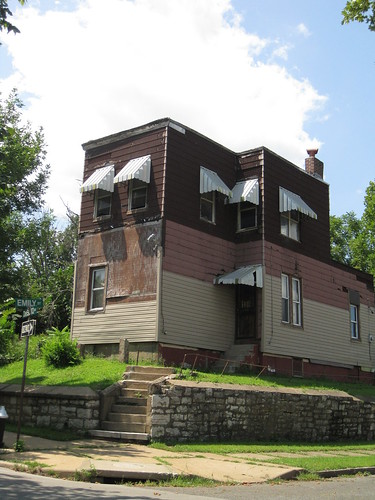 Unfortunately, the house -- built in 1893 and missing many of its College Hill neighbors -- has been vacant since 2007. The corner entrance through the retaining wall is another thoughtful feature. Under the layers of siding, there may be the home's original wooden siding. The cornice is long gone. Still, rehabilitation would be easy, with the two-story frame house in great shape for a building of its age and construction method.
Unfortunately, the house -- built in 1893 and missing many of its College Hill neighbors -- has been vacant since 2007. The corner entrance through the retaining wall is another thoughtful feature. Under the layers of siding, there may be the home's original wooden siding. The cornice is long gone. Still, rehabilitation would be easy, with the two-story frame house in great shape for a building of its age and construction method.
Saturday, August 22, 2009
Behind the Scenes Tour at the Conservatory
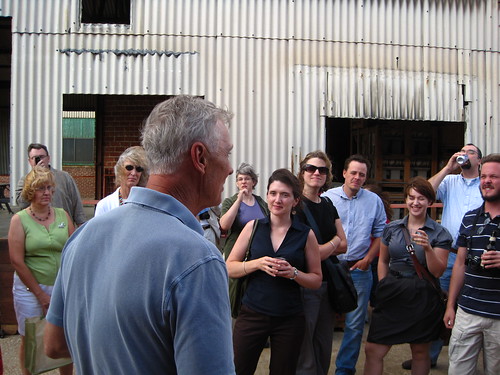
Amid unusually pleasant weather, over 100 people attended yesterday's happy hour and tour at the St. Louis Building Arts Foundation Conservatory in Sauget, Illinois. The event was a joint fundraiser for the Foundation and the Chatillon-DeMenil House Foundation. Guests enjoyed food and drink while exploring the 15-acre, 13-building historic steel foundry that serves as the Conservatory. The site is home to some 300,000 architectural artifacts and eventually a research library of rare literature related to architecture and allied arts.
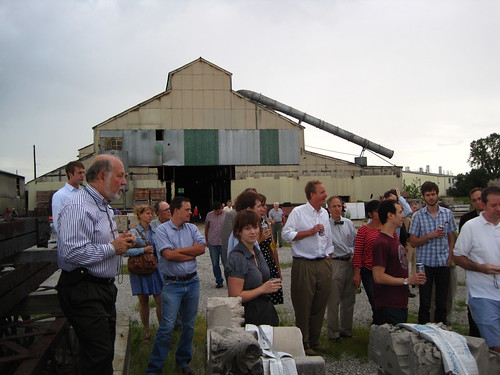 The last time that the Conservatory was open for a public tour was nearly one year ago. While more events are planned for the future, including a fall party, the chance to get an all-access tour of the Conservatory was a rare one.
The last time that the Conservatory was open for a public tour was nearly one year ago. While more events are planned for the future, including a fall party, the chance to get an all-access tour of the Conservatory was a rare one.Thanks go to Lynn Josse, board member of both organizations, bon vivant Ray Brewer, grill masters Mike Rodgers and Jeff Detie, Building Arts Foundation President Larry Giles, Chatillon-DeMenil House Foundation President Ted Atwood and many others who worked to pull the event together.

This is one of two events for the Chatillon-DeMenil House this weekend: On Sunday, August 23rd, Doug Harding will give a talk entitled "Shadows of Immortality: 19th Century Photography." Using examples from the DeMenil collection, Mr. Harding will delve into the history of photography and actually demonstrate how photographs were made. The public is invited to bring in their own photographs for dating. This free talk begins at 2pm at the house, 3352 DeMenil Place at Cherokee.
Avalon Theater Now Sports For Sale Sign
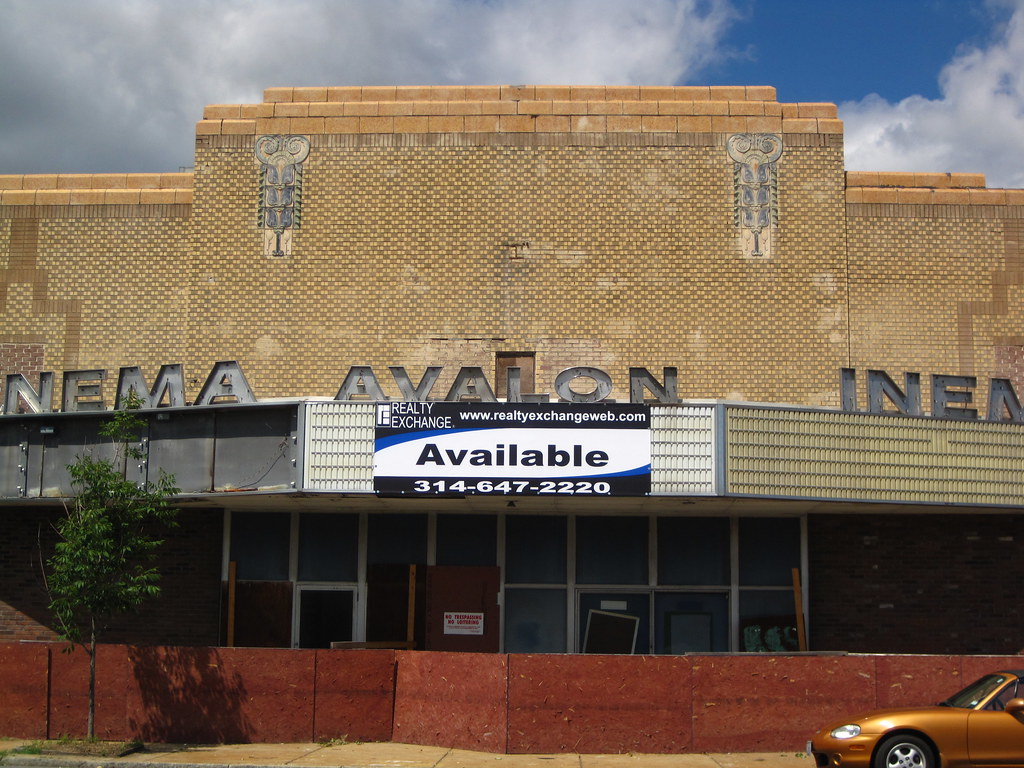 The Avalon Theater at 4225 S. Kingshighway is sporting a for-sale sign for the first time since it closed in 1998. Why didn't this sign go up years ago, before much of the deterioration started? Well, the City of St. Louis was not trying to gain trusteeship over the defunct Sopo Corporation that owns the Avalon. On May 11, the City Counselor's Office filed suit against the corporation seeking to have the city appointed trustee to dissolve the corporation's assets -- namely, the Avalon Theater. The next hearing is scheduled for September 14 before Judge Robert Dierker.
The Avalon Theater at 4225 S. Kingshighway is sporting a for-sale sign for the first time since it closed in 1998. Why didn't this sign go up years ago, before much of the deterioration started? Well, the City of St. Louis was not trying to gain trusteeship over the defunct Sopo Corporation that owns the Avalon. On May 11, the City Counselor's Office filed suit against the corporation seeking to have the city appointed trustee to dissolve the corporation's assets -- namely, the Avalon Theater. The next hearing is scheduled for September 14 before Judge Robert Dierker.For years, Greg Tsevis has acted as owner of the theater, and has told people that the historic neighborhood theater is for sale at prices ranging from $1 million to $2 million. The trouble is that Tsevis' parents never appointed successor trustees to their corporation before passing away, meaning that Tsevis technically not the owner.
The listing price is familiar: $1 million. How valid would a sales contract with Sopo Corporation be? That's a good question, but the high listing price almost certainly guarantees that question won't be asked.
Friday, August 21, 2009
Loans to NorthSide in the News
McEagle was not Corn Belt's only St. Louis customer. Corn Belt had a branch office in Clayton and made numerous real estate loans in the St. Louis market. To date, only one of those loans has been resolved through a deed of release filed by the Federal Deposit Insurance Corporation.
The problem with Corn Belt was that it was undercapitalized. Illinois regulators first issued a cease and desist order in December 2008 ordering the bank to resolve many problems with its management including "engaging in hazardous lending and lax collection practices."
According to McKee, the loans with Corn Belt had the interest rolled into the loan so that there were no monthly payments. While such an arrangement was desirable to McKee (and, frankly, any other customer!), such loans sound exactly like "hazardous lending."
Corn Belt is one of two banks that have made loans to the NorthSide project. The other bank is the Bank of Washington in Washington, Missouri. In January, the Bank of Washington extended a line of development credit to McEagle with a maximum amount of $27.6 million. Securing this loan are the holdings of six McEagle north side holding companies (Larmer, Union Martin, Babcock Resources, Dodier Investors, MLK 3000 and Sheridan Place).
Perhaps related to the loan to the NorthSide project is the loan of $20 million in Capital Purchase Program funds to the Bank of Washington in May. These funds were created as part of the Obama administration's stimulus funding initiative.
L.B. Eckelcamp, bank chairman and prominent Republican political donor, told The Missourian in May that "[the funding] will allow us to remain extremely well capitalized and still increase our ability to take deposits and make loans by more than $100,000,000."
Thursday, August 20, 2009
Edwardsville Residents Rally for Buildings Housing Small Businesses
The bottom line: a law firm wants to demolish six small-scale storefront buildings now home to small businesses. These buildings are all historic, with some older than 100 years. However, some of the buildings were reclad or greatly altered over time. Indeed, some of them are barely recognizable as historic buildings.
However, the tenants and others oppose the move not just because these buildings are old. The opposition stems from recognition that downtown Edwardsville needs buildings like these to retain small business and vital street scapes. Giant new office buildings take away not only the low rents that foster commerce, but the differentiation in a block face that makes it a welcoming environment. Preservation here is not essentially about saving something old, or something pretty, but something that encourages a mode of business conducive to building community. Maybe someday someone will restore the facades of these buildings, but even if that never happens the buildings are working just fine.
Downtown Edwardsville's commercial district has seen a resurgence of small business activity, and retaining storefronts is essential to future growth. Like many downtowns, Edwardsville's has plenty of surface lots where a new office building could be built. There is no reason why the lawyers seeking their own building and the small businesses cannot coexist.
Wednesday, August 19, 2009
Brick Thieves Assail Presumed Legacy Property
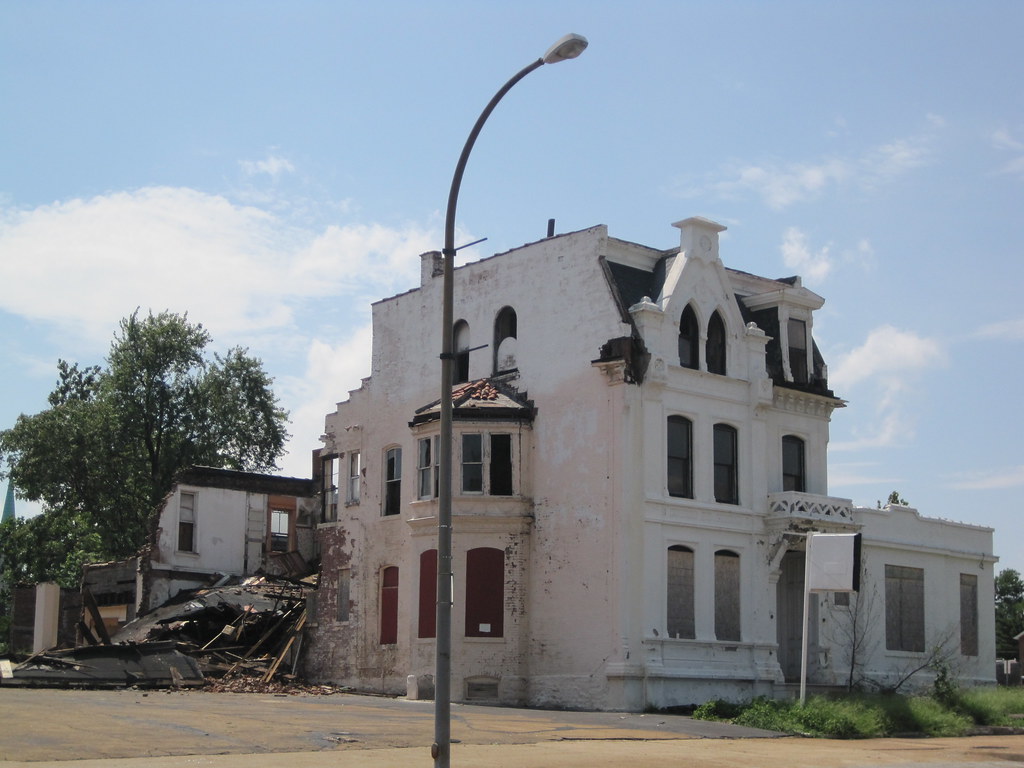 Criminals can work pretty damn fast, as the condition of the McEagle Properties-owned house at 1930-6 St. Louis Avenue shows. Two weeks ago, the vacant house was sound. Last Wednesday, the side wall had started to come down at the hands of the north side vultures (see "The Precarious Condition of Two Houses on St. Louis Avenue," (August 12, 2009). Today, almost all of the ell of the old house stood destroyed. The bricks no doubt have cycled through Pope's or one of the other yards around 25th and University, then on to hands more legally clean of fencing stolen goods but no less complicit.
Criminals can work pretty damn fast, as the condition of the McEagle Properties-owned house at 1930-6 St. Louis Avenue shows. Two weeks ago, the vacant house was sound. Last Wednesday, the side wall had started to come down at the hands of the north side vultures (see "The Precarious Condition of Two Houses on St. Louis Avenue," (August 12, 2009). Today, almost all of the ell of the old house stood destroyed. The bricks no doubt have cycled through Pope's or one of the other yards around 25th and University, then on to hands more legally clean of fencing stolen goods but no less complicit.Meanwhile, McEagle has taken no visible step to safeguard the over 150 historic buildings that it owns in north St. Louis, or work with residents to report brick thieves, who prey also on other buildings. Perhaps no one has seen the activity here. After all, thieves picked apart many buildings to the south of this house, McEagle emptied the three houses to the east of this building and two of the three buildings across the street is vacant. Four years ago, the brick thieves would have been afraid to pick on this block, and now they seem to be able to rule the roost.
However, what is done is done. Complaining about the past won't secure a future for the McEagle-owned historic buildings across north city. What will do the trick is actual preservation planning: architectural survey of St. Louis Place and JeffVanderLou, listing of eligible buildings and districts, placement of the 5th and 19th wards in preservation review (solely the responsibility of the alderwomen) and strict rules about security and stabilization as part of the redevelopment ordinances facing the Board of Aldermen. If McEagle and planner Mark Johns of Civitas are serious about saving "legacy properties," it's time to tell us how they will do that.
The facts on one hand: Brick thieves demolishing McEagle buildings. Historic buildings deteriorating and left open to the elements. On the other: A promise. Promises don't save historic buildings, or we'd all be rehabbers. I don't mean to condone or chastise McEagle for the past failures, but urge the developer and city leaders to take action now as part of the negotiation. If McEagle lacks the capacity, then it should work openly with the city and other developers who can bring funds for preservation planning, stabilization and rehabilitation. We can't save everything, and we've lost a lot. (We lost more in St. Louis Place and JeffVanderLou before McEagle arrived, in fairness.) Yet we can take the circumstances we have and turn a developer's promise into action that will reassure residents of north St. Louis that McEagle is as serious about the attempt as it is about the sell.
Storefront Additions: West Florissant and Linton
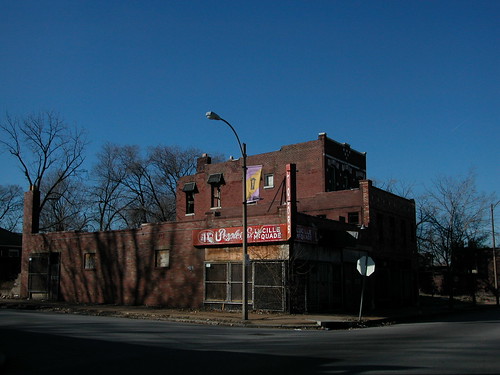 The striking group of vacant buildings at the northwest corner of West Florissant and Linton Avenues (3900-4 West Florissant Avenue, technically) in the Fairgrounds neighborhood has long attracted the attention of photographers, amateur architectural historians and passer-by. The colorful name on the liquor store sign at the corner, Lucille McQuade, tempts the imagination to conjure Lucille. Sassy liquor store owner, sitting behind the corner with a quick no bullshit face for the teenagers trying to buy a Colt? I don't know, but I do know Lucille's old store is not long for this world.
The striking group of vacant buildings at the northwest corner of West Florissant and Linton Avenues (3900-4 West Florissant Avenue, technically) in the Fairgrounds neighborhood has long attracted the attention of photographers, amateur architectural historians and passer-by. The colorful name on the liquor store sign at the corner, Lucille McQuade, tempts the imagination to conjure Lucille. Sassy liquor store owner, sitting behind the corner with a quick no bullshit face for the teenagers trying to buy a Colt? I don't know, but I do know Lucille's old store is not long for this world.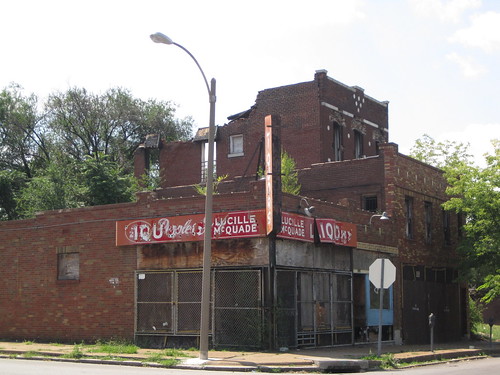 Two years have passed since I took the first photograph in this post. The three buildings now look even worse. Well, the corner building (built in 1933) is same and sound, although the enamelled sign board has been crumpled by a would-be thief. The two-story house, built in 1896, was first robbed of limestone keystone and voussoirs above the second floor windows. Then came the fire in May of this year that triggered collapse of most of the building structure. The formal front elevation struggles to maintain its composure, and the side walls are largely intact. However, anything wooden has fallen down where gravity has lured all buildings forever.
Two years have passed since I took the first photograph in this post. The three buildings now look even worse. Well, the corner building (built in 1933) is same and sound, although the enamelled sign board has been crumpled by a would-be thief. The two-story house, built in 1896, was first robbed of limestone keystone and voussoirs above the second floor windows. Then came the fire in May of this year that triggered collapse of most of the building structure. The formal front elevation struggles to maintain its composure, and the side walls are largely intact. However, anything wooden has fallen down where gravity has lured all buildings forever.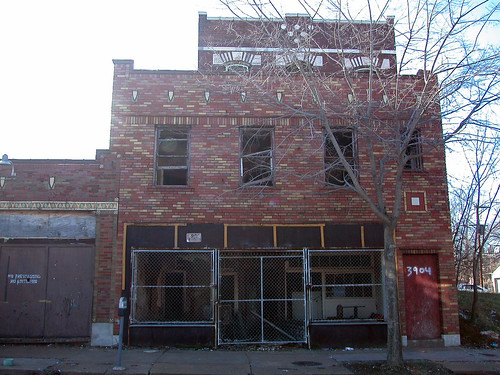 Yet all is not lost, because the house's commercial front (built some time after 1933) is intact. This front actually covers the front and wraps around the side. Bricks from the house have fallen through the roof, perhaps, but this fireproof building addition is intact and could be rescued from its crippled parent. The pale-toned tapestry brick and the terra cotta shields are particularly bright on this building. Notice how the new front is built over the pier of the one-story corner store, which shares some of its vocabulary.
Yet all is not lost, because the house's commercial front (built some time after 1933) is intact. This front actually covers the front and wraps around the side. Bricks from the house have fallen through the roof, perhaps, but this fireproof building addition is intact and could be rescued from its crippled parent. The pale-toned tapestry brick and the terra cotta shields are particularly bright on this building. Notice how the new front is built over the pier of the one-story corner store, which shares some of its vocabulary.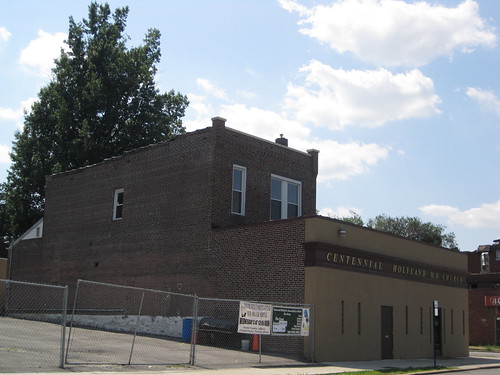 If we lose the buildings on one side of Linton, we have two other storefront additions on the other. United Railways built a street car line on West Florissant between 1910 and 1915, and as residents of older neighborhoods like Old North and Hyde Park moved in this direction, there was demand for more retail. The residential buildings around this intersection were located near earlier commercial buildings, and adaptation into commercial use was logical for owners. The tenement building above, located at 3856 West Florissant Avenue, was built in 1890 and built out to the sidewalk with a store in 1927.
If we lose the buildings on one side of Linton, we have two other storefront additions on the other. United Railways built a street car line on West Florissant between 1910 and 1915, and as residents of older neighborhoods like Old North and Hyde Park moved in this direction, there was demand for more retail. The residential buildings around this intersection were located near earlier commercial buildings, and adaptation into commercial use was logical for owners. The tenement building above, located at 3856 West Florissant Avenue, was built in 1890 and built out to the sidewalk with a store in 1927.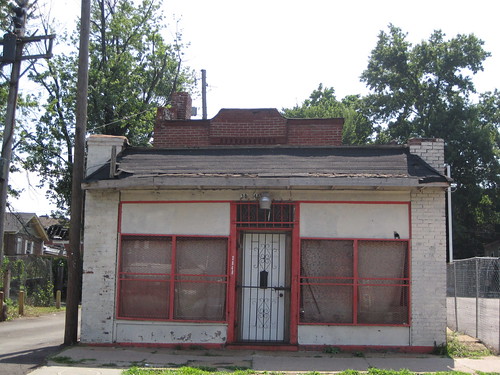 On the same block at the alley line is the building at 3848 West Florissant Avenue. The house is a small brick shaped-parapet structure on a raised foundation dating to 1892. The commercial addition dates to some time after 1910. Use has come full circle, as the storefront is now used as a residence.
On the same block at the alley line is the building at 3848 West Florissant Avenue. The house is a small brick shaped-parapet structure on a raised foundation dating to 1892. The commercial addition dates to some time after 1910. Use has come full circle, as the storefront is now used as a residence.
Tuesday, August 18, 2009
Mid-Century Modern Update from Washington, Missouri
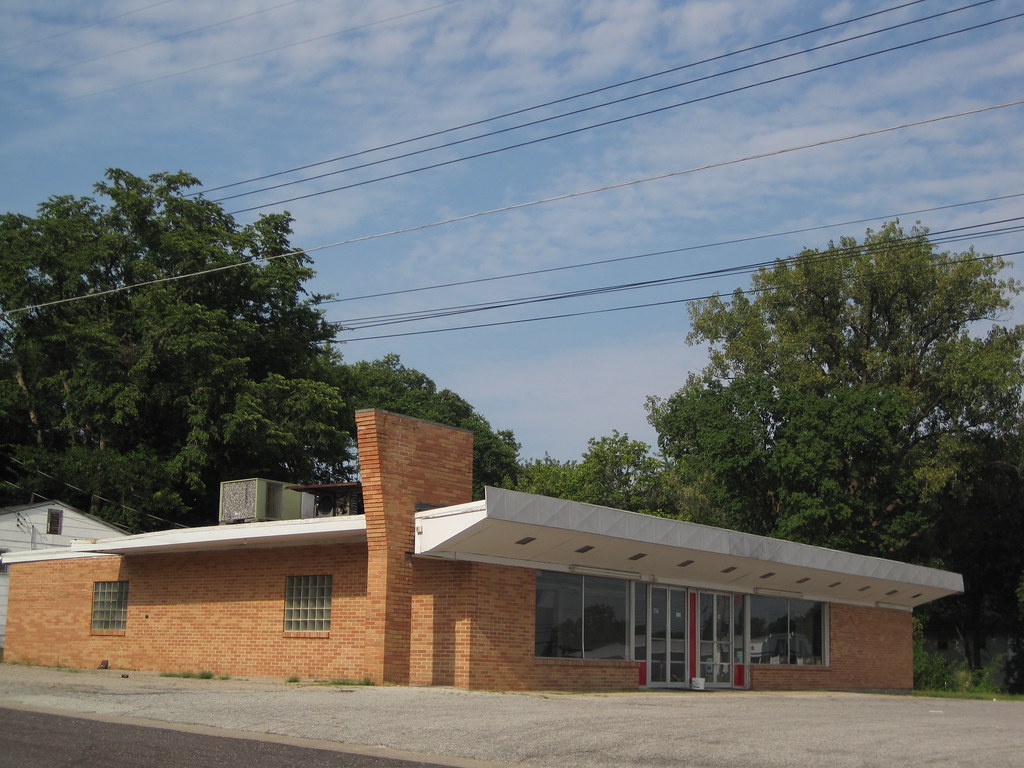 The historic mid-century Patke's Dairy building at 1805 Fifth Street in Washington, Missouri is now for sale (see listing here). The dairy had been owned and operated by the Patke family at that location for over 50 years. There is a great sign in front, too.
The historic mid-century Patke's Dairy building at 1805 Fifth Street in Washington, Missouri is now for sale (see listing here). The dairy had been owned and operated by the Patke family at that location for over 50 years. There is a great sign in front, too.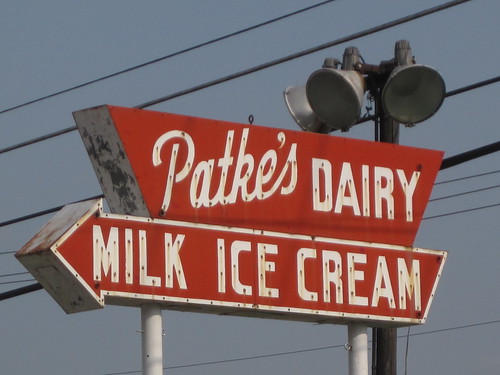 Also in Washington, the Bank of Washington has completely refurbished the swanky sign that advertised their drive-through lanes. Unfortunately, the bank grossly altered its 1950s-era building. The bank added two floors to the two-story streamline building and clad the expanded building in a common, confused proto-classical envelope. However, it's good that the sign is back!
Also in Washington, the Bank of Washington has completely refurbished the swanky sign that advertised their drive-through lanes. Unfortunately, the bank grossly altered its 1950s-era building. The bank added two floors to the two-story streamline building and clad the expanded building in a common, confused proto-classical envelope. However, it's good that the sign is back!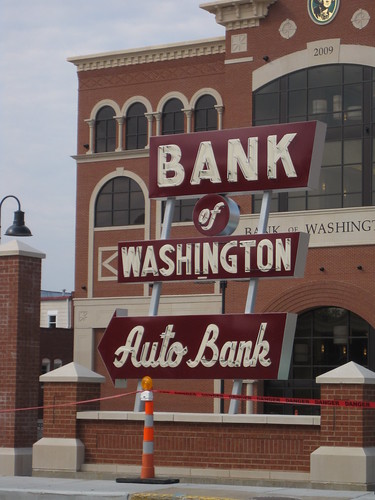
Architectural Creativity on Prairie Avenue
 Two blocks of Prairie Avenue on each side of West Florissant Avenue are home to some of the most interesting small houses from St. Louis' 19th century vernacular past. Above is the two-flat at 2111 East Prairie. This unique duplex dates to 1884 and is the lone survivor of a row of four. The trapezoidal entrance bay with its tall, narrow windows gives an otherwise conventional box a commanding street presence. The contrast between the masonry cornice work on this bay and the rest of the building reinforces the presence of the entrance. Now, this has been converted into a single-family home.
Two blocks of Prairie Avenue on each side of West Florissant Avenue are home to some of the most interesting small houses from St. Louis' 19th century vernacular past. Above is the two-flat at 2111 East Prairie. This unique duplex dates to 1884 and is the lone survivor of a row of four. The trapezoidal entrance bay with its tall, narrow windows gives an otherwise conventional box a commanding street presence. The contrast between the masonry cornice work on this bay and the rest of the building reinforces the presence of the entrance. Now, this has been converted into a single-family home.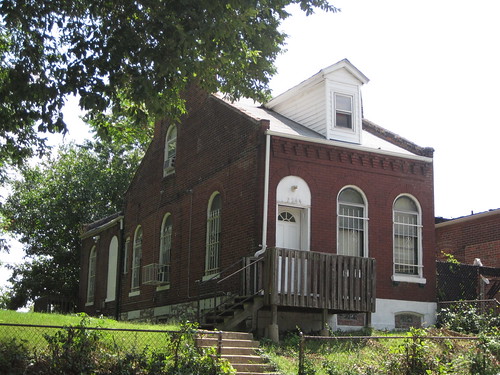 Across the street toward Florissant Avenue is the side-gabled house at 2144 East Prairie, built in 1885. Homes like this are common across St. Louis, but how many have Roman arches over all window and door openings -- not just on the front, but on the sides as well?
Across the street toward Florissant Avenue is the side-gabled house at 2144 East Prairie, built in 1885. Homes like this are common across St. Louis, but how many have Roman arches over all window and door openings -- not just on the front, but on the sides as well? While not eccentric like the others here, I had to mention the frame house at 2128 East Prairie, built in 1884. This side-entrance house is in fine shape, and worthy of preservation. Owned by the Land Reutilization Authority and located in the ailing College Hill neighborhood, there are already two strikes against the house.
While not eccentric like the others here, I had to mention the frame house at 2128 East Prairie, built in 1884. This side-entrance house is in fine shape, and worthy of preservation. Owned by the Land Reutilization Authority and located in the ailing College Hill neighborhood, there are already two strikes against the house. 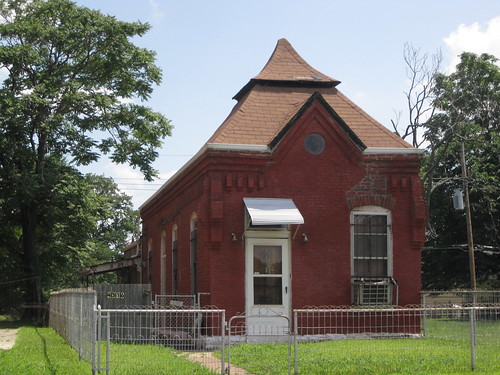 One block west across Florissant stands one of the coolest shotgun houses ever built in our fair city. The house at 4316 Prairie (the bend in the street changes numbering from east-west to north-south) dates to 1896 and is fully within the fin de siecle ecclectic vein that hit American architecture then. The double pyramidal roof may be unique to a house of this size in St. Louis. Alas, this house is also a survivor of a row of four identical houses. The houses at 4312 and 4314 were LRA-owned and demolished in 2004, while the fourth house at 4310 was lost before 1980. In 2002, Landmarks Association of St. Louis prepared a nomination to the National Register of Historic Places of the three remaining house paid for by Community Development Block Grant funds, but for some reason the organization and Alderman Freeman Bosley Sr. (D-3rd), who represents this area, never proceeded with submission of the nomination.
One block west across Florissant stands one of the coolest shotgun houses ever built in our fair city. The house at 4316 Prairie (the bend in the street changes numbering from east-west to north-south) dates to 1896 and is fully within the fin de siecle ecclectic vein that hit American architecture then. The double pyramidal roof may be unique to a house of this size in St. Louis. Alas, this house is also a survivor of a row of four identical houses. The houses at 4312 and 4314 were LRA-owned and demolished in 2004, while the fourth house at 4310 was lost before 1980. In 2002, Landmarks Association of St. Louis prepared a nomination to the National Register of Historic Places of the three remaining house paid for by Community Development Block Grant funds, but for some reason the organization and Alderman Freeman Bosley Sr. (D-3rd), who represents this area, never proceeded with submission of the nomination. These two blocks of Prairie Avenue lie in different neighborhoods -- east of West Florissant is College Hill, and west is Fairground(s). Both neighborhoods are within the city's Third Ward. These blocks are each largely devoid of houses at all these days, with over 50% of the parcels on each street face vacant. Thus, the odd houses stand out more. However, I think their unique qualities must have seemed even stranger when contrasted with so many more conventional vernacular buildings around them. Context is always key.
Keep Your Buildings Standing to Keep Your Neighborhoods Strong
Monday, August 17, 2009
Behind the Scenes at St. Louis' Future Architecture Museum This Friday

Photographs of the Foundation's amazing facility across the river can be found online here. The former Sterling Steel Casting complex, built between 1923 and 1959, is an attraction in itself.
St. Charles County Preserving Open Space
The county plans to spend $3.34 million for a 60-acre property owned by Robert J. and Patricia Day Barnard and a contiguous, 115-acre property owned by New Melle Lakes Development Co. and Apted-Hulling Inc.
(Anyone else surprised to see Apted-Hulling still around?) Besides these sizable acquisitions, the parks system in the county has received other donations from concerned families:
The Wolks are the fourth family to donate land to the county park system. Two of those donations are parks in reserve - 91 acres northwest of O'Fallon donated by Dolores Freymuth, and 100 acres south of Highway 364 (Page Avenue extension) and west of the Missouri River donated by Bill and Nancy Knowles. Officials hope to open the Old Boyd Plantation and Towne Park, donated by Betty Towne, next year.
The St. Charles County Parks Department now owns 2,855 acres and hopes to own 4,000 acres by 2015. These numbers are encouraging. If the past 25 years were years where St. Charles County leaders aggressively pursued development of rich farm land, maybe the next 25 will be years of sensible land conservation. As growth declines in that county, the time is right to safeguard land.
Thursday, August 13, 2009
St. Louis American Editorializes on North Side Preservation
San Luis Column Spacing, Partitions Were Not Limiting
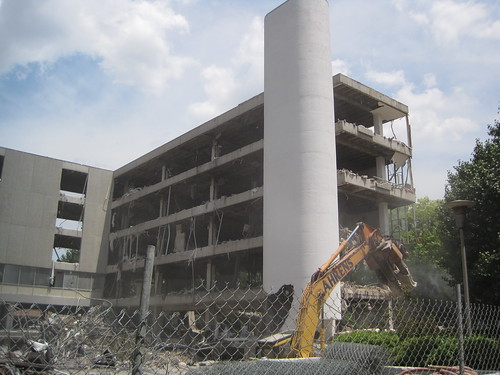 Even before the Building Division issued the demolition permit for the San Luis Apartments (originally the DeVille Motor Hotel), interior demolition began. That work showed anyone who passed by that the assertion by the St. Louis Archdiocese that the building's tiny, "prison-like" (as one staff member put it) rooms impeded rehabilitation was false. The room partitions crumpled at the strike of the Bobcat, and their removal had no structural bearing.
Even before the Building Division issued the demolition permit for the San Luis Apartments (originally the DeVille Motor Hotel), interior demolition began. That work showed anyone who passed by that the assertion by the St. Louis Archdiocese that the building's tiny, "prison-like" (as one staff member put it) rooms impeded rehabilitation was false. The room partitions crumpled at the strike of the Bobcat, and their removal had no structural bearing.Moreover, demolition showed us that the the DeVille's column spacing was far more generous than represented by the Archdiocese. The photograph above shows that the columns on the wings were located only on the sides of the concrete floor plates. Once the partitions were removed, we all saw wide open floors that could be configured any way a developer wished.
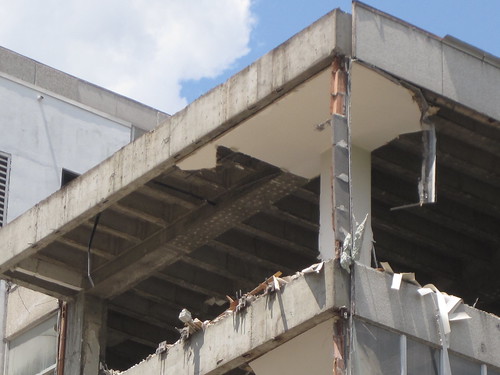 Look at that generous open space between the columns, and the ample ceiling height. There were many possibilities for reuse. At the Preservation Board, the Archdiocese and its architect Dan Jay gave the impression that the column spacing and motel-sized rooms were fixed limits to the future use of the building. Not so.
Look at that generous open space between the columns, and the ample ceiling height. There were many possibilities for reuse. At the Preservation Board, the Archdiocese and its architect Dan Jay gave the impression that the column spacing and motel-sized rooms were fixed limits to the future use of the building. Not so.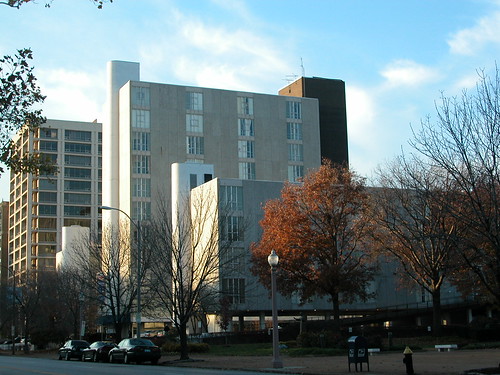
Why the Friends of the San Luis Continue
On July 27, Circuit Court Judge Robert Dierker, Jr. dismissed the Friends of the San Luis' petition for injunctive relief. The petition sought to stop demolition of the San Luis Apartments so that the Friends could file an appeal of the Preservation Board’s approval of the demolition. Dierker not only dismissed the case, but did so on the basis that the Friends had no legal standing to bring forth a preservation appeal under the city’s preservation laws.
So, the building is gone and the case dismissed. Why are the Friends of the San Luis still fighting?
If left unchallenged, Judge Dierker’s ruling could set case precedent that citizens and advocacy groups lack the right to appeal decisions of the Preservation Board. Since the Preservation Board and its enabling laws govern the entire city, all citizens are affected by the decisions of the Board and deserve the right to appeal on procedural grounds.
Why would the Friends of the San Luis care about the right to appeal? Didn’t you want to save one building?
True, our organization was formed to advocate for a specific building. Yet our ability to do so was undercut by Dierker’s decision. The members of the Friends of the San Luis are active in other preservation matters in which the right to appeal is essential. If people have to go to court to prove our right to participate on every matter, concerned citizens won’t be able to actually fight for our city’s historic buildings. We must legally clarify that right to protect citizen preservation advocacy.
Okay. What’s next?
We will file an appeal of Dierker’s ruling to the Missouri Court of Appeals on the basis of his narrow definition of who has appeal rights. That appeal must be filed within 30 days of the ruling. Then, the Missouri Court of Appeals will schedule its hearing.
What if you lose at the Missouri Court of Appeals?
We could appeal further to the Missouri Supreme Court. However, if the St. Louis preservation ordinance’s right to appeal is not clear enough to withstand appellant judicial review, then there is a bigger problem than one judge’s point of view. Then we will know that the ordinance itself needs more clear language protecting citizen right to appeal.
Wednesday, August 12, 2009
The Precarious Condition of Two Beautiful Houses on St. Louis Avenue
 Brick rustlers have returned to the lovely stone-faced house at 1930-6 St. Louis Avenue (see ""Who Would Destroy This Building?", January 7, 2007). Most recently a funeral home, the house was first built in 1873 by wholesale grocery merchant Bernhard Winkelmann. Winkelmann was one of the numerous new-money German-Americans whose lavish homes gave St. Louis Avenue the nickname "Millionaire's Row." Today, a different millionaire owns the property: developer Paul J. McKee, Jr. through holding company N & G Ventures.
Brick rustlers have returned to the lovely stone-faced house at 1930-6 St. Louis Avenue (see ""Who Would Destroy This Building?", January 7, 2007). Most recently a funeral home, the house was first built in 1873 by wholesale grocery merchant Bernhard Winkelmann. Winkelmann was one of the numerous new-money German-Americans whose lavish homes gave St. Louis Avenue the nickname "Millionaire's Row." Today, a different millionaire owns the property: developer Paul J. McKee, Jr. through holding company N & G Ventures. The damage from 2007 concerned only a one-story flat-roofed addition behind the home, but this week's damage concerns the side wall of part of the house. Since joists run laterally and rest in the brick side walls of most 19th century buildings, this damage will eventually cause collapse of the roof and floors. However, the thieves have only struck an addition to the Winkelmann house's ell, so the original section is not yet damaged.
The damage from 2007 concerned only a one-story flat-roofed addition behind the home, but this week's damage concerns the side wall of part of the house. Since joists run laterally and rest in the brick side walls of most 19th century buildings, this damage will eventually cause collapse of the roof and floors. However, the thieves have only struck an addition to the Winkelmann house's ell, so the original section is not yet damaged.On May 21 and other occasions, McKee mentioned having a list of 60 "legacy properties" in his possession worthy of preservation. Is this house one of them? It should be. However, the list is a mystery to myself and many people in city government and the development world with whom I have discussed preservation issues related to the NorthSide project. We do know that the house at 1930 St. Louis Avenue made an official list that gives it undisputed historic status: the house is a contributing resource to the Clemens House-Columbia Brewery Historic District. It ought to be preserved, and McKee should secure it against further attack.
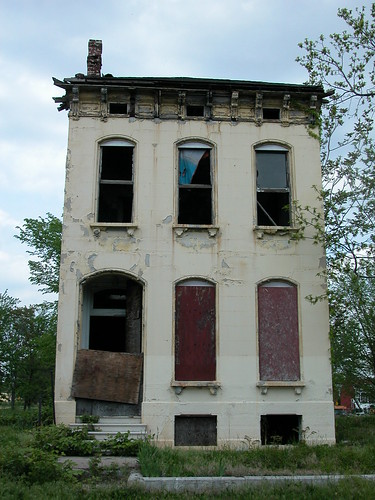 Across the street is another fine stone-faced house with a lovely wooden Italianate cornice. The house at 1925 St. Louis Avenue dates to 1879 and is owned by the city's Land Reutilization Authority (LRA). The house is outside of the present historic district boundary. The front looks ragged but sturdy, but a walk around the side reveals the sad truth.
Across the street is another fine stone-faced house with a lovely wooden Italianate cornice. The house at 1925 St. Louis Avenue dates to 1879 and is owned by the city's Land Reutilization Authority (LRA). The house is outside of the present historic district boundary. The front looks ragged but sturdy, but a walk around the side reveals the sad truth.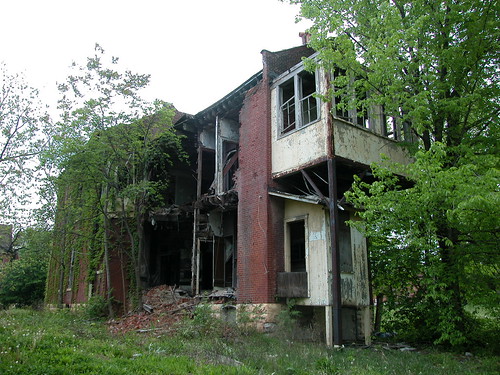 The east side wall of the ell is in shambles, although the second floor and roof are holding on for now. The condition of this house raises a preservation question related to NorthSide that has not been widely discussed: what happens to the numerous vacant historic buildings within the NorthSide footprint not owned by McEagle Properties and its subsidiaries? Most of those buildings are on the list of needed properties that McEagle submitted to the city's Tax Increment Financing Commission in May. Is the building at 1927 St. Louis Avenue one of the 60 "legacy properties"? There ar emore than 60 historic buildings owned by McEagle worthy of preservation, and at least as many in the project area owned by LRA and other entities.
The east side wall of the ell is in shambles, although the second floor and roof are holding on for now. The condition of this house raises a preservation question related to NorthSide that has not been widely discussed: what happens to the numerous vacant historic buildings within the NorthSide footprint not owned by McEagle Properties and its subsidiaries? Most of those buildings are on the list of needed properties that McEagle submitted to the city's Tax Increment Financing Commission in May. Is the building at 1927 St. Louis Avenue one of the 60 "legacy properties"? There ar emore than 60 historic buildings owned by McEagle worthy of preservation, and at least as many in the project area owned by LRA and other entities. City officials should not wait for the list of legacy properties to set into motion a sensible preservation plan for the NorthSide project. If public financing is on the table, that can be leveraged to ensure that buildings like the two above can be mothballed for eventual redevelopment in future phases of the NorthSide project.
Tuesday, August 11, 2009
Doug Hartmann Gets Two Years, Life of Shame
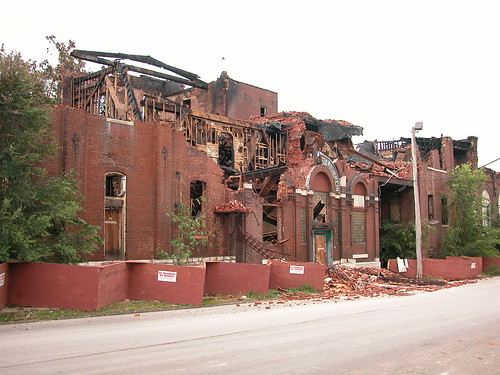 The fire-damaged Nord St. Louis Turnverein is just the most spectacular instance of the impact of Doug Hartmann's real estate empire on the city of St. Louis. During Hartmann's negligent ownership, the Turnverein went up in a huge blaze on July 6, 2006. Hartmann's wild ride was already over, actually, and a sale of the property to developer Peter George was underway. George went on to close, and plans to rebuilt the landmark at great cost. If only Hartmann had been half as generous.
The fire-damaged Nord St. Louis Turnverein is just the most spectacular instance of the impact of Doug Hartmann's real estate empire on the city of St. Louis. During Hartmann's negligent ownership, the Turnverein went up in a huge blaze on July 6, 2006. Hartmann's wild ride was already over, actually, and a sale of the property to developer Peter George was underway. George went on to close, and plans to rebuilt the landmark at great cost. If only Hartmann had been half as generous.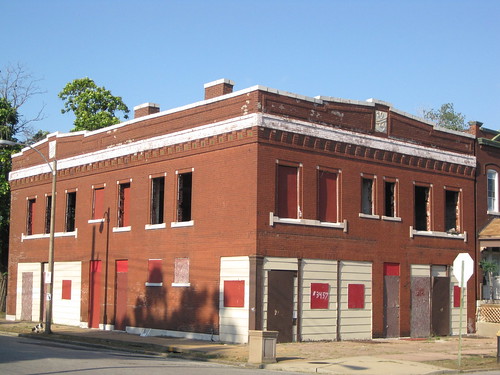 The Turnverein is an egregious example. Most of Hartmann's nearly 150 properties in the city ended up like the corner storefront at the northeast corner of Wyoming and Arkansas avenues in Tower Grove East. Built in 1906, the building was shabby but occupied before Hartmann's DHP Investments purchased it in 2006. Some work took place, including removal of the second floor windows. Then, everything stopped. Eventually, the building reverted to the city's Land Reutilization through tax default. To this day, the weeds regularly grow waist high around the building, and a reuse timeline is not certain.
The Turnverein is an egregious example. Most of Hartmann's nearly 150 properties in the city ended up like the corner storefront at the northeast corner of Wyoming and Arkansas avenues in Tower Grove East. Built in 1906, the building was shabby but occupied before Hartmann's DHP Investments purchased it in 2006. Some work took place, including removal of the second floor windows. Then, everything stopped. Eventually, the building reverted to the city's Land Reutilization through tax default. To this day, the weeds regularly grow waist high around the building, and a reuse timeline is not certain. The building at Arkansas and Wyoming is like others that Hartmann accumulated to keep his Ponzi scheme afloat: occupied when purchased, and left a vacant nuisance. Hartmann's grand plans of taking stable but not gut-rehabbed old buildings and turning them into top-dollar rehabs convinced many investors and banks to finance his fraudulent scheme. In retrospect, the buildings were better off as-is, and the whole mess was a symptom of a momentary development binge.
Last Thursday, Hartmann, of the 1300 block of Crooked Stick Drive in O'Fallon, Missouri, received the lenient sentence for which he had bargained with prosecutors: two years, plus $34 million in restitution that U.S. District Judge Henry Autrey admits will likely never be collected. (Have investigators checked for a Hartmann Swiss bank account?)
Acting United States Attorney Michael W. Reap ought to be ashamed for this pathetic sentence deal. The damage that Hartmann has done to city neighborhoods has taken more than two years to sort out, and much remains to be sorted. Hartmann could be a free man before the corner building at Arkansas and Wyoming is rehabbed.
The sad fact is that the drug runners who use Hartmann's buildings for operations will face stiffer time in the slammer when they get locked up. If only these folks could meet Hartmann in prison! Of course, our white suburban fiend gets the justice that he does not deserve: a slap on the wrist in a cozy white-collar jail for bankrupting good people, cheating investors and leaving neighborhoods more vulnerable. Those who protest the inequity of our justice system are vindicated again. However, Hartmann will hardly be a free man upon return. We know his crimes too well now.
More "Urban" Is Not Always Better
 The old Raiffie Vending Company building at 3663 Forest Park Avenue may not look like much, especially since its owner has let it sit without windows for the past three years. However, the two-story modern brick building has great qualities. Built in 1948, the building has a streamline modernist style that, while not greatly articulated here, is quietly attractive. Since the windows were part of the building design, the stylistic character was more clear before removal. Built of steel and brick masonry, the building is solid. This is the type of construction that is infinitely adaptable and practical for almost any use imaginable.
The old Raiffie Vending Company building at 3663 Forest Park Avenue may not look like much, especially since its owner has let it sit without windows for the past three years. However, the two-story modern brick building has great qualities. Built in 1948, the building has a streamline modernist style that, while not greatly articulated here, is quietly attractive. Since the windows were part of the building design, the stylistic character was more clear before removal. Built of steel and brick masonry, the building is solid. This is the type of construction that is infinitely adaptable and practical for almost any use imaginable. Of course, your mind might change when you see the new hotel that Sasak Corporation plans to build on the site of the modern warehouse. Five stories tall with wide street-level retail openings, this building adds more building density and urban connection to the site. Its masonry work is more interesting than that of the plain little box that now occupied the site, right? The hotel is a more urban building, you might think, and will add urban vitality to the site. Despite some flaws, like the 100-space garage in back being visible from the street through a pointless drive in front, this building makes the block more "urban" than the Raiffie building and thus constitutes an improvement.
Of course, your mind might change when you see the new hotel that Sasak Corporation plans to build on the site of the modern warehouse. Five stories tall with wide street-level retail openings, this building adds more building density and urban connection to the site. Its masonry work is more interesting than that of the plain little box that now occupied the site, right? The hotel is a more urban building, you might think, and will add urban vitality to the site. Despite some flaws, like the 100-space garage in back being visible from the street through a pointless drive in front, this building makes the block more "urban" than the Raiffie building and thus constitutes an improvement.Wrong.
Here is where the difference between rendering and reality comes into play. The developers are proposing to build this hotel at a cost of $90 per square feet, a price range below that of your average do-it-yourself Old North rehab. The masonry may look lovely in a tiny JPG, but it's not going to be brick in real life. The hotel will be clad in precast panels, spaced by those oh-so-obvious black seams.
Is the shift to "more urban" worth it if it means throwing away better construction for a cheaply-built building that meets all of the rote urbanist qualities? I say no emphatically. We can't keep throwing away buildings while we sit on an alarming amount of vacant land. There are many other sites in Midtown where a hotel could be built, and the old warehouse at 3663 Forest Park itself could be adapted if the developers wanted to try. But they'd have to spend more than $90 per square foot.
Monday, August 10, 2009
I Support Marcia and Roger!
All should be well in St. Louis nearly five years after the last scrap of building material was moved off site. Then why does the lawsuit against Roger Plackemeier and Marcia Behrendt persist?
That lawsuit is a pointless lingering thread that threatens the livelihood of two citizens who fought a gallant fight and did not prevail. The suit's plaintiffs include the Old Post Office development company formed by DESCO and DFC Group, the Missouri Development Finance Board and the city via the Land Clearance for Redevelopment Authority. Perhaps the developers have an axe to grind, but why do the public entities persist?
Citizen participation is an important right in our democratic system, and its exercise unfortunately often is fruitless. Such was the case here, at least in terms of preserving a building. The citizens who fought to save the Century Building renewed the energy and relevance of historic preservation and urban design in St. Louis, providing encouragement to a new generation of advocates.
The counter-suit against Marcia and Roger is set for trial on September 14, and they need help raising funds for their legal defense. I plan to give generously, and urge all those who want to truly move past the Century Building battle to do the same. Details follow.
The Royale Treatment
Wednesday, August 12 from 6:00 - 8:00 p.m.
The Royale, 3132 S. Kingshighway
The Century Building may be gone, but not forgotten! Preservationists Marcia Behrendt and Roger Plackemeier are defendants in a SLAPP suit from the City of St. Louis and the State of Missouri over the demolition of this historic landmark. You can aid their defense and show a support for St. Louis’ architectural treasures.
Dave Drebes Players will be the featured entertainment. Complimentary appetizers will be provided by the Royale. Suggested donation of $5 at the door.
Downtown residents, Marcia Behrendt and Roger Plackemeier, took action in attempt to save the Century Building. They were plaintiffs in litigation that, among other things, sought to prevent its demolition and save our city’s architectural heritage. The City of St. Louis, the State of Missouri and the project developers filed a counter lawsuit against them, alleging malicious prosecution — and seeking actual damages exceeding $1.5 million, plus punitive damages “in an amount sufficient to deter said defendants and others from like conduct.”
This malicious prosecution has continued for over four years and the trial is set for September 14, 2009.
Marcia and Roger took a stand for their neighborhood – downtown – and all who love our City’s architectural heritage. The lawsuit against them is a classic SLAPP suit - a strategic lawsuit against public participation. Presumably the city and state, through agencies, have unlimited funds to pursue these two individuals for years. This is where you can help! Marcia and Roger need assistance with their legal costs. Your donation will help.
Please come and support Marcia and Roger and learn more about the status of the litigation and what you can do to help.
All donations will be accepted and are tax-deductible. Check or money orders should be payable to ReVitalize St. Louis and mailed to:
Royale Treatment – Downtown Defense Fund
C/o ReVitalize St. Louis
PO Box 771751
St. Louis, MO 63177
Royale Treatment – Downtown Defense Fund is sponsored by ReVitalize St. Louis and the Royale. ReVitalize St. Louis is a registered 501c3 nonprofit organization. For more information, please visit http://www.rvstl.org. To learn more about the Royale, please visit http://www.theroyale.com
Sunday, August 9, 2009
Can St. Louis Lure Small Businesses?
Has this trend pushed small business out of the Big Apple? If so, what can smaller cities do to lure some of the entrepreneurs that might end up looking for a more encouraging urban business environment?
While Chicago has been a beneficiary of New York's terrible policies, St. Louis could lure some of the business. St. Louis has an abundance of historic commercial districts, where old buildings offer cheap rents and low purchase prices. Small business owners can afford to rent a small space in New York and maybe an entire building in Chicago. In St. Louis, they can buy a building -- or two. The low cost of living is a base incentive.
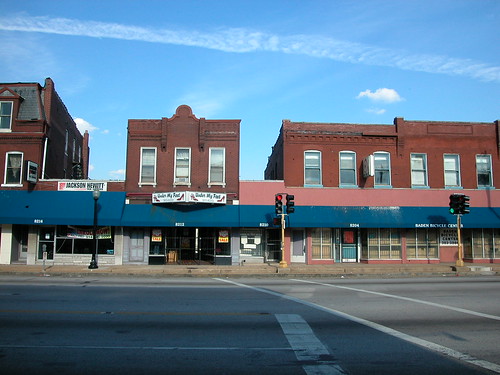
However, St. Louis needs more than a low cost of living and old buildings to draw businesses from larger cities. We need better urban planning policies to promote commercial districts by retaining storefront buildings and keeping out fast food, drug stores and other uses that break up urban streetscapes needed to draw shoppers. We need public sector investment in infrastructure like sidewalks, alleys and lighting. The business license fees and sales tax rates in the city are too high, especially on food and drink. Most of all, we need to break down the ward-by-ward differences in business and license policy with strict citywide standards that make sense to people from the outside world.
I'm not suggesting that a wave of would-be New Yorkers are coming. In fact, many of the small business owners we need to attract are those who chose Clayton, St. Charles or Belleville -- or Memphis, Cleveland or Kansas City -- over the city proper. The bottom line is that we have to create a city that not only has sensible small business policy but actively encourages small business to keep our neighborhood commercial districts thriving.
I would be very interested in comments from city small business owners.




